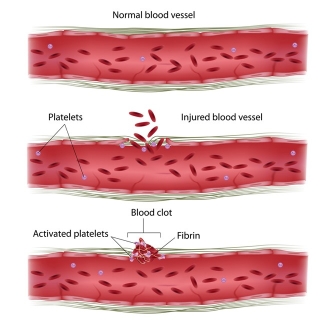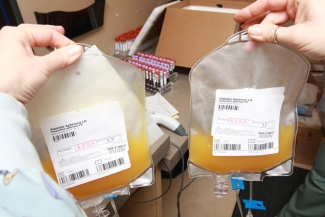Developing safer drugs for heart attack and stroke patients
Wednesday, March 01, 2017 Dr. Kendra Hodgkinson

Platelets are essential for the formation of blood clots to stop bleeding. However, if platelets are activated when they’re not supposed to be, a clot can form within a blood vessel, blocking blood flow. These clots can cause medical emergencies such as heart attacks and strokes, which are major causes of illness and death worldwide.
Current therapies to treat and prevent blood clot formation are associated with potentially dangerous bleeding side effects. Researchers at Canadian Blood Services are working on developing new drugs that don’t have these side effects but still provide effective treatment. The findings from two of our research projects were recently published in high-quality peer-reviewed journals (Blood and the Journal of Thrombosis and Haemostasis).
β3 integrin - Dr. Heyu Ni
Dr. Heyu Ni is a Scientist with the Canadian Blood Services Centre for Innovation. His research team located at the Keenan Research Centre for Biomedical Science at St. Michael's Hospital developed a “designer antibody” that targets an important protein in platelets: β3 integrin. β3 integrin is essential for platelets to clump together and form a blood clot.
They found that blocking the activity of β3 integrin with their new antibody prevented blood clots in animal models. Interestingly, this antibody did not cause significant bleeding side effects, unlike other drugs currently used to treat and prevent blood clots.

If clinical trials with this new antibody show similarly positive results, this research could lead to a new drug that treats clotting with minimal side effects. This would be tremendously valuable for Canadian patients living with cardiovascular disease. Dr. Ni’s group is continuing to develop this new antibody for future clinical trials.
Factor Xa - Dr. Ed Pryzdial and Dr. William Sheffield
Another research group, led by our own Dr. Pryzdial at the Centre for Blood Research at UBC with assistance from another Centre for Innovation researcher, Dr. Sheffield located at McMaster University, took a different approach. They looked at the molecules surrounding blood clots and discovered that one molecule that helps clots form, factor Xa, also helps clots dissolve. However, before factor Xa can acquire its clot-dissolving function, it must bind to the clot. As a result, a drug based on factor Xa may be able to help dangerous clots dissolve without causing harmful bleeding throughout the body.
This group found that their new drug was effective at dissolving clots in a mouse model. Unlike mice treated with currently approved clot-dissolving drugs, mice treated with the new drug did not show signs of clot-dissolving activity throughout the body. The new drug also acted as an anticoagulant to slow clot formation in mice.
Like the antibody developed by Dr. Ni’s group, this new drug based on factor Xa will need to be tested carefully in clinical trials before it can help Canadian patients, but these early results are very promising. Read more about this study in our January Research Unit.
What's next?
Both of these projects provide examples of how Centre for Innovation research could be mobilized into new drugs for the benefit of Canadian patients, returning value to our funders. With respect to current Canadian Blood Services operations, both discoveries could one day improve the utilization of blood products by reducing the need for cardiac surgery.
A plain language summary by Tyler Stratton and Yiming Wang in Dr. Ni's research group supported the development of this post.
Canadian Blood Services – Driving world-class innovation
Through discovery, development and applied research, Canadian Blood Services drives world-class innovation in blood transfusion, cellular therapy and transplantation—bringing clarity and insight to an increasingly complex healthcare future. Our dedicated research team and extended network of partners engage in exploratory and applied research to create new knowledge, inform and enhance best practices, contribute to the development of new services and technologies, and build capacity through training and collaboration.
The opinions reflected in this post are those of the author and do not necessarily reflect the opinions of Canadian Blood Services nor do they reflect the views of Health Canada or any other funding agency.
Related blog posts
Blood is red. That’s because of the red blood cells or erythrocytes that whizz around your veins and arteries. The colour is a great visual marker, both clinically and emotionally, but sometimes its very redness hides the other important components that are in you to give. These include plasma, the...
Meet Dr. Elisabeth Maurer: she uses lasers to measure quality of platelets

